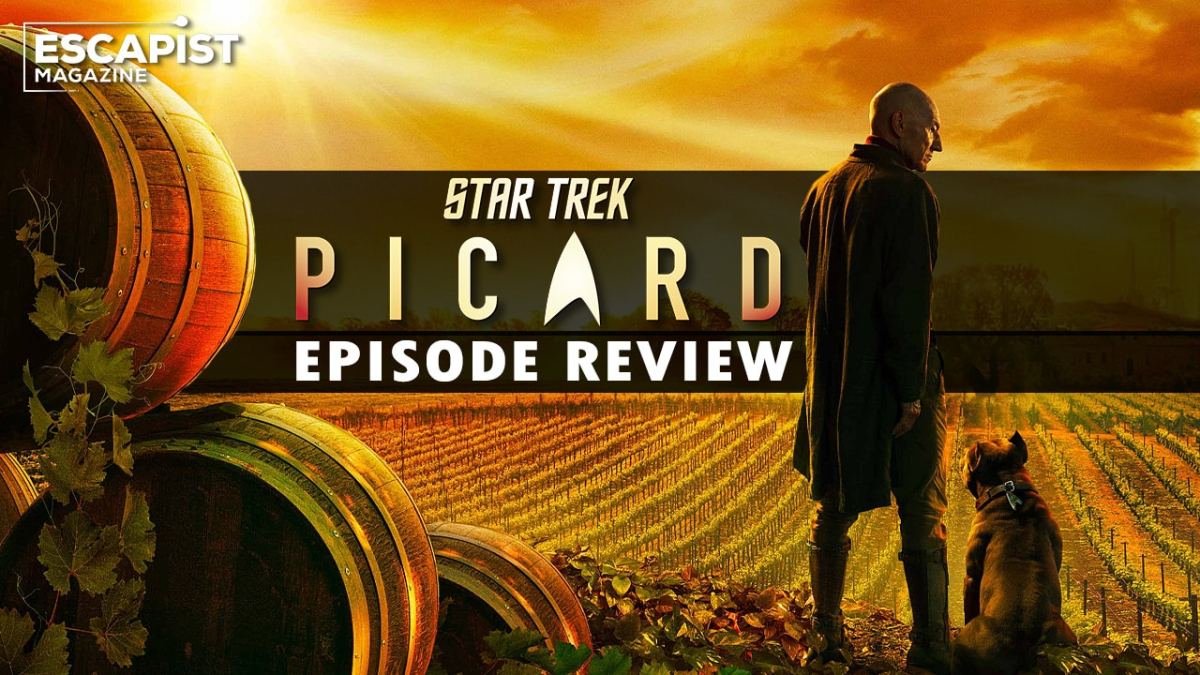This review contains spoilers for Star Trek: Picard, episode 2, “Maps and Legends.”
Enter the Romulans! We saw glimpses of Romulan death squads in the series premiere, beaming in and eventually killing Dahj Asha, the synthetic that presents one of the central mysteries of the show thus far. Here, we begin to see just how deep the Romulan threat truly is and get more of Narek (Harry Treadaway), whom we only briefly met in the first episode.
Seeing the Romulan death squad in that first episode, my first reaction was disappointment. The fascistic relatives of the Klingon often came off as too static to me. Their society was very secretive, and it often made their motivations too muddy to dig into, and their threat, though big in the moments when our crew met them, didn’t feel as meaningful as, say, that of the Borg.
“Maps and Legends” is seemingly on a mission to make me eat my words, as we start to see just how the Romulans can be made interesting, or at least human. We see them just going about their day, and though it still isn’t a lot, we experience them as living creatures, not just evil villains. This is years after the supernova that took out Romulus and years more after they decided to go fully into isolation, where they have spent most of their history. Yet Star Trek never really showed us what an isolated Romulan Empire looks like. We see Narek as a person, and even though his personality has a level of deception on the surface, there is more going on with him.

We learn more about the death squad, the Zhat Vash, a predecessor to the Tal Shiar, the Romulan Secret Police. At the beginning of the episode, we didn’t know why the Zhat Vash wanted to kill Dahj. Here, a little more is uncovered.
They hate synthetics, for one. Rizzo, one of the Romulans undercover in the Federation, refers to synthetics as “Abomination” and that they need to find the others. “Abomination” is a loaded word, especially given how Romulans are often coded as fascist. It is a word used to dehumanize the other in the real world. Considered with the events on Mars, a fascist framing may be the intended reading.
We start the episode watching that synthetic uprising on Mars. The non-synthetic workers mock and insult the synthetic working with them, and suddenly we see a spark in his eye. He kills a couple of the workers and starts the ignition of the atmosphere before killing himself. This isn’t framed as free will but rather as a glitch that, with the later context from the Romulans, doesn’t feel like an accident.
A central tenet of fascism is “othering” people and using them as scapegoats, and when events don’t fit within that narrative, the context is often shifted to blame those that they need to “other.” It is made clear that the Romulans hate synthetics, and as the fascist-coded empire, making a synthetic glitch in order to take out these synthetics once and for all makes perfect sense.

This brings us to Jean-Luc Picard, a man who trusts synthetics as people and wanted nothing more than to save Romulans, despite their being an enemy to the federation. He has his hand in both pots, and this makes his curiosity toward the mystery of Dahj’s death so important and the Romulans such an important threat.
Picard is denied almost immediately when he heads back to Starfleet looking for answers and a mission. He wants to take a small reconnaissance ship with a skeleton crew to find Bruce Maddox and Dahj’s twin to find answers, but he is rebuked. His televised anger is a reason given, in addition to the amount of damage a mission that sensitive could cause, but it is clear there is more going on. The Romulans have infiltrated Starfleet, and that’s part of the reason why there is so much hostility.
Earlier, Picard spoke to a doctor. He has cancer, so his motivation widens from just finding answers and getting back into the adventure of Starfleet to fighting against time, knowing that this adventure might just be his last. This helps us understand the motivations of Jean-Luc through the episode and why, after being denied by Starfleet, he is willing to break the rules. Patrick Stewart has always been a phenomenal performer, and here we see a man defined by calm and thoughtful reflection starts to realize that he might not be around forever, and it’s all shown through his eyes. It’s hard to pull off a quiet man with internal toil without coming off as either boring or overacted, but one of Stewart’s great talents as an actor has been finding that balance.

What I don’t love is the idea that his cancer made him lose his cool in the interview. Yes, Picard is a generally stoic man, but it was powerful that the idea of Starfleet refusing to save lives simply because they were enemies is enough to bring him to rage. The Federation allowed a genocide to happen, and it feels like it is minimizing the importance of Picard’s decision to leave, how repugnant he finds what Starfleet has become.
“Maps and Legends” also begins to assemble a crew. We already met Agnes Jurati (Alison Pill), who comes in to help Picard with his search, but the new addition is Raffi (Michelle Hurd), whom we only meet briefly. Picard clearly has a history with her, and he explicitly contacts her because she probably hates him. That’s new. Rarely on The Next Generation would a member of the crew be actively antagonistic towards Picard, and though Roddenberry’s original vision of having little to no interpersonal conflict within the crew acts against that idea, I am curious to see what they can do with it.
They will also be working without the blessing of Starfleet; it will be interesting to see what kind of moral quandaries Picard and his crew will be able to grapple with. To me, the most compelling parts of Star Trek are when a morally good action comes up against Starfleet rules. This is every time a crew breaks the Prime Directive, or when the captain breaks a direct order as Picard did in the events leading up to the series. Without Starfleet, the consequences and discussions around the choices Picard might make are wide open, and I am excited to see where they decide to take it.
Overall, “Maps and Legends” was a mixed bag. On one hand, it hints at some really interesting ideas around how Romulans fit into this universe in a way that hasn’t been explored yet. However, the willingness to undercut emotionally complex moments is concerning. Regardless, I’m still all in and ready to explore.





Published: Jan 30, 2020 06:12 pm